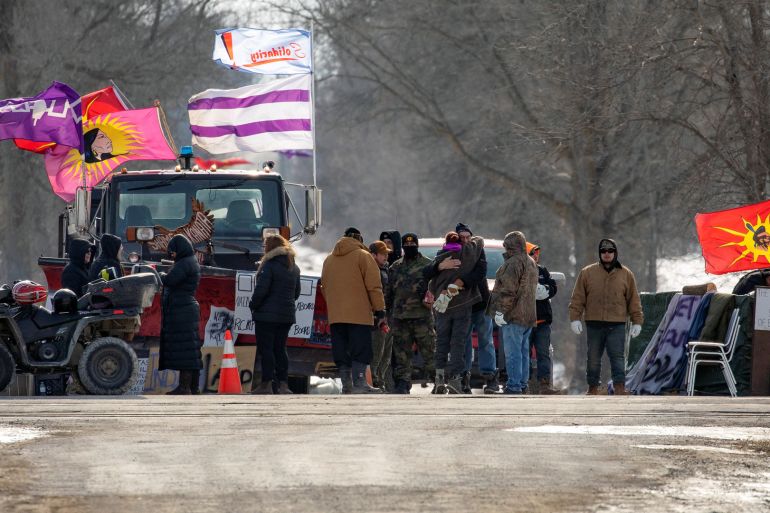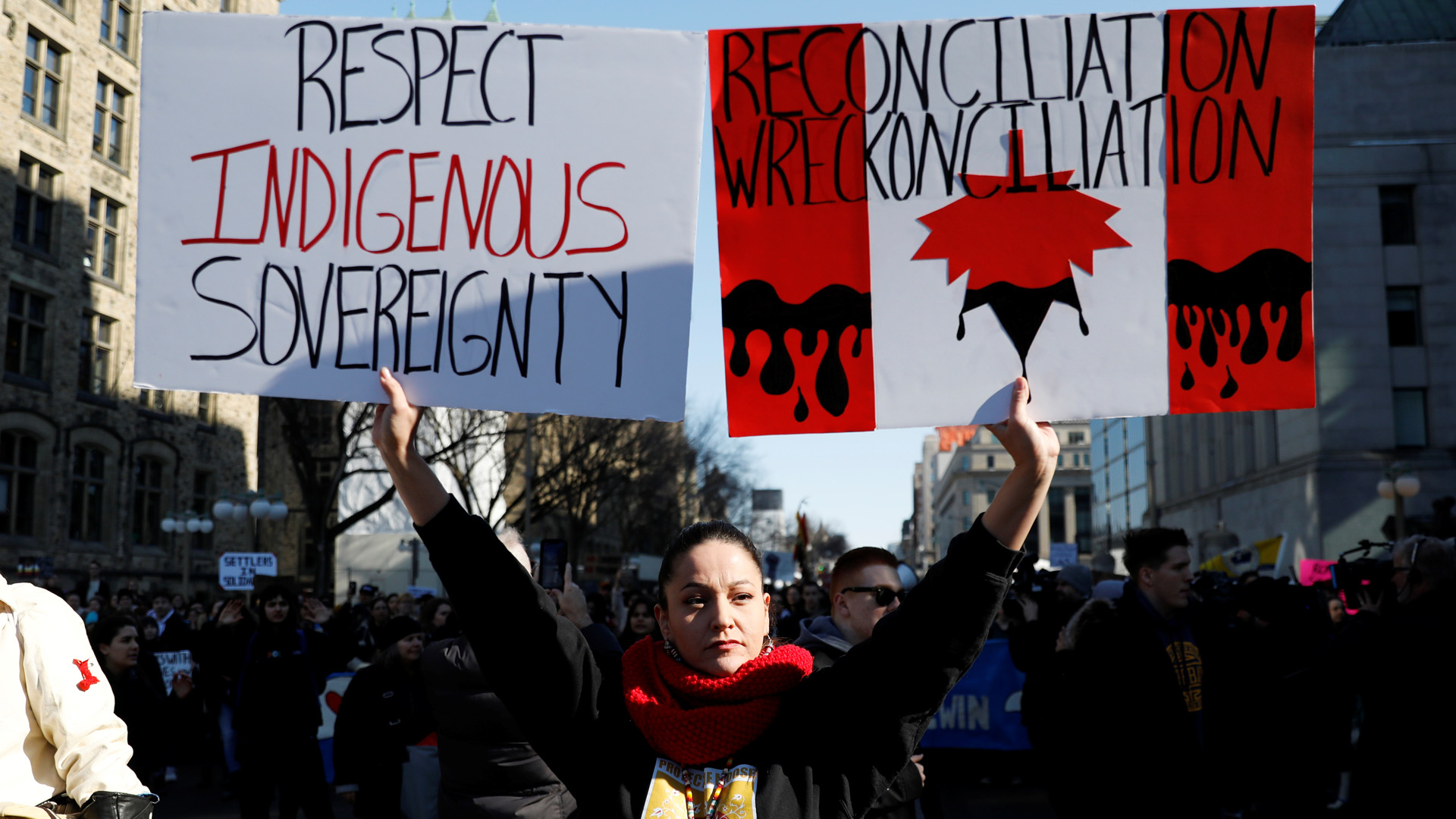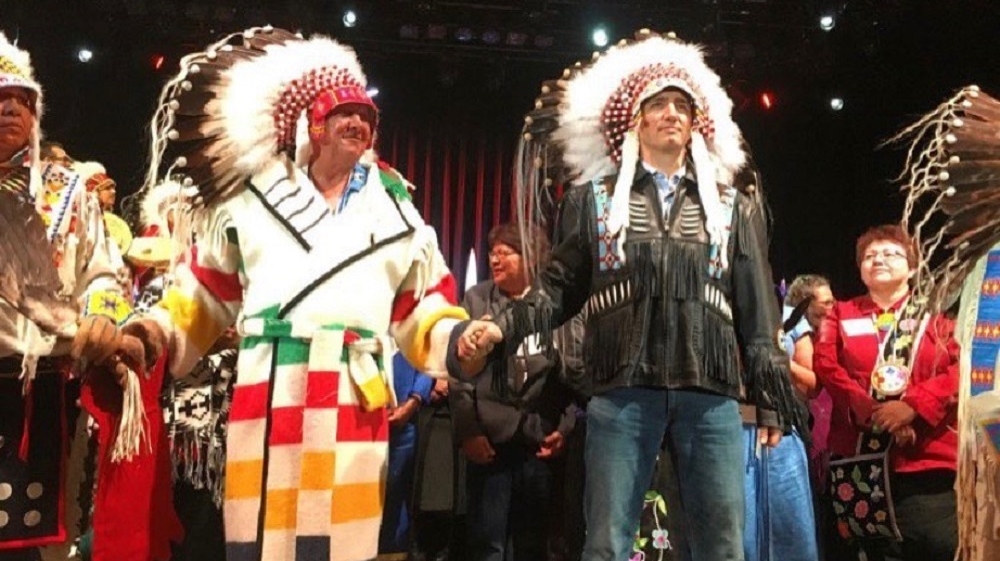‘Our hearts bled’: Covering the Wet’suwet’en crisis in Canada
A journalist reflects on what weeks of protests mean for the land’s Indigenous – and how it goes beyond just a pipeline.

Alberta, Canada – The past month has been strained, emotional, tense. Covering the Wet’suwet’en crisis as an Indigenous journalist has been a challenge.
In British Columbia, the hereditary chiefs of the Wet’suwet’en tribe are opposing the construction of a natural gas pipeline through their traditional lands – a protest that has sparked a David and Goliath-style battle with industry, governments and Canadian law enforcement. It set off an uprising of Indigenous peoples and their allies across Canada and beyond, inspiring many to stand in solidarity and uphold their own rights.
Keep reading
list of 4 itemsIndigenous people in Philippines’s north ‘ready to fight’ as tensions rise
Curfew announced for under-18s in Australia’s Alice Springs after unrest
‘We exist’: A Himayalan hamlet, forgotten by Indian democracy
In early February, thousands watched live feeds of the Royal Canadian Mounted Police (RCMP) moving in on Wet’suwet’en land defenders after the pipeline owner – Coastal GasLink, now known as TC Energy – directed police to enforce a court injunction allowing it to remove the “obstacles” and continue preconstruction work.
The first arrests were made in the dark of night. We watched the next round happen during the day against the backdrop of snow-blanketed mountains.
On the Morice River bridge – the only access point to the construction pipeline – land defenders hung red dresses a chilling symbol of the epidemic of missing and murdered Indigenous women and girls. Violence against Indigenous women has in part been linked to industrial activity. The dresses were later ripped down by Coastal GasLink workers when the land defenders were taken away – a move that seemed symbolic of how dangerous it is for Indigenous women living near industrial developments.
Beneath the Morice River bridge flows what Wet’suwet’en Hereditary Chief Namoks told me is untarnished water – pristine enough that people can still drink straight from the river. The remote area is environmentally intact and untainted by human activity – making it one of the last of its kind in the world.
The land defenders were unarmed. The RCMP advanced with rifles and dogs. Days later, a video surfaced of young land defenders at the top of a wooden tower built near the Unist’ot’en healing camp – a Wet’suwet’en traditional healing centre – as one of them yells at the officers that he is unarmed. In the distance, a sniper is seen pointing his gun at them.
‘No relocation’
The RCMP blocked First Nations hereditary chiefs and some Wet’suwet’en members from accessing their unceded ancestral lands, while Coastal GasLink workers were escorted along the roads to make way for the pipeline.
Indigenous peoples and their allies decried industry being given precedence over human rights. These are rights defined by Article 10 of the United Nations Declaration on the Rights of Indigenous Peoples (UNDRIP), which says in part that “Indigenous peoples shall not be forcibly removed from their lands or territories. No relocation shall take place without the free, prior and informed consent.”
The UNDRIP is one of the most comprehensive international instruments defining the rights of Indigenous peoples and essentially the only safeguard that exists to uphold them.
Not every state recognises it. Canada was finally set to implement the declaration into law, which would have reformed the way the government and the industry uphold Indigenous rights. But amidst the Wet’suwet’en crisis, Prime Minister Justin Trudeau stalled the adoption of the UNDRIP.

Sparks of hope ignite
The Wet’suwet’en drama grew. It was chaotic, and unlike anything I had ever witnessed before. Journalists working to document the turbulent scenes were held back by police. Rail and port blockades sprung up at key infrastructure routes. Fires burned day and night at sites of protests in the mid-winter cold. The fires kept people warm and, in their alliance, they felt the sparks of hope ignite.
Pressure built. Canadians started to notice. Many soon felt inconvenienced by the blockades and the hold-up of a pipeline that promises instant economic security.
Indigenous peoples’ world view looks ahead for the wellbeing of the next seven generations: a future of clean land, air and water for our children and their children.
In an era of extreme weather changes and a climate crisis, humanity’s way of life is under threat and there is a need to protect and sustain what is left. Many Indigenous peoples are ready to defend Mother Earth to her end. But, in return, some are receiving death threats.
Across the world, much has been taken from Indigenous peoples – from colonisation to assimilation policies, to being entrapped in territories by governments. But the injustices have also unleashed a collective desire to rise.
There is a belief among the Indigenous that our generation was foretold long ago on these very lands by our ancestors. That this generation would help bring back balance to a world ravaged by greed and industrialisation. We are their living prayers walking out an Indigenous renaissance. A cultural, artistic, political, and economic rebirth in which we are carrying the responsibility of revolutionary change.
Nation-to-nation building
A couple of weeks into the protests, Conservative politicians demanded that Trudeau take action to stop the land defenders because they said they were paralysing key infrastructure, railways and ports. But he held back, saying it was an opportunity for respectful dialogue with the hereditary chiefs and not a time for hastily made decisions. After all, his number one priority is to repair the relationship between Canada and Indigenous peoples here – he has been touting this since he was first elected in 2015.
I was there to witness an epic honouring ceremony held at the TsuuT’ina Nation near Calgary, Alberta in March 2016. Everyone was hopeful. There was an expectation that Trudeau would carry out his promises for nation-to-nation building and the wellbeing of Indigenous peoples.

More than 100 elected chiefs from across Canada attended along with thousands of locals. TsuuT’ina Chief Roy Whitney called the event a Thunderbirds Awakening and encouraged Trudeau to “seize the moment” because it was “important for the survival of First Nations”.
Trudeau was given an Indian name in the TsuuT’ina language, Gusmistiyi, meaning “the one that keeps trying”.
I watched them crown him with a feathered war bonnet and he called the relationship with First Nations a “sacred obligation”. He joined hands with the chiefs and, with great celebration, danced around the room to the beat of roaring drums and tribal songs.
Raid after raid
Then on February 21, it seemed as though Trudeau stopped trying. He gave the go-ahead for police to enforce the removal of Indigenous land defenders and their allies at various blockades across the country.
Police dispatched in the hundreds. Unarmed Mohawk allies in Tyendinaga, Ontario asserting their sovereignty on their own territories were forcefully removed by police officers.
Not long after, Gitxsan Matriarchs and a hereditary chief were arrested on their own lands just down the highway from the Wet’suwet’en territory. Reports surfaced of raid after raid on Indigenous peoples and allies all over the country.
We watched it through live feeds and replays on media outlets with a narrative from a predominantly non-Indigenous perspective. And our hearts bled. Elders sang prayer songs. Some cried. The youth drew more inspiration to stand against the status quo.
Tug of war between two worlds
Many Indigenous people in Canada and around the world are dying due to land loss, suicide, poverty, murder – in part because of the racism and hatred that is rampant in some areas and systemically embedded into mainstream societies. Indigenous people living on the lands they have inhabited for thousands of years carry the most adverse statistics of incarceration rates, access to healthcare, housing, education and quality of life.
There is a tug-of-war between two worlds pulsing through my veins. My Cree and Iroquois ancestors have walked these lands for time immemorial. Some of my French ancestors came here to make war with them. But I have the strength and blood of thousands of warriors carrying the songs of my ancestors, holding the dreams of both sides alive.
Sometimes I feel like a bridge between the two worlds.
We are living with a mess that desperately needs healing and reconciliation.
Canada has a history of colonial violence against Indigenous peoples. But an Indigenous solidarity is unfolding because there is unity in a vision for liberation from oppression.
This renaissance, this dawning of a new era of justice and hope, is not going anywhere. This is not about a pipeline. It is about way more than that. It is about Indigenous rights, sovereignty, protecting the environment and revolution. I am here to document it all.
And the war cry for justice and a new way forward is spreading wildly.